
The IEC 60335-1 standard, in its 4th edition, ensures even better fire protection in unattended electrical household appliances. To achieve this goal, the demands placed on glow wire resistance of the plastics used for insulating or mounting live components have been increased.
The IEC 60335 standard on the 'Safety of household and similar electrical appliances' comprises two parts. Part 1 (IEC 60335-1) is the basic standard governing the majority of the general requirements placed on all electrical household appliances, while Part 2 (IEC 60335-2-xx) – see Table 1 – is appliance specific and governs special features such as whether an appliance is deemed unattended or attended, the definition of the test procedures, tests concerning improper use as well as metrics including pollution degree.
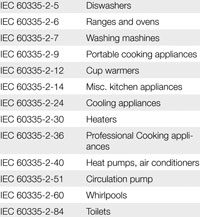
Part 1, Paragraph 30.2 'Test of heat and fire resistance' (see Figure 1), defines various requirements for insulating plastics. As specified in the revised 4th edition of IEC 60335-1 (which came into effect in May 2001), insulating materials used for live components in unattended appliances whose current exceeds 0,2 A must meet higher demands in glow wire testing. The plastic materials’ after-flame times have been shortened accordingly.
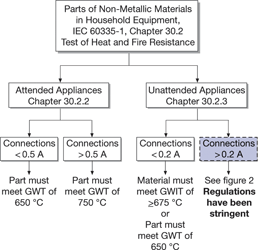
Part 2, Paragraph 30.2, defines whether an appliance is deemed to be attended or unattended and whether it uses the relevant components, such as fuse holders, appliance couplers, timers, circuit breakers for equipment, relays, motors and locks. Basically, the rule applies that appliances with a built-in timer or program controller or appliances operated by remote control are deemed unattended, while portable appliances are deemed attended.
However, there may also be attended and unattended versions within a Part 2 standard, eg, the grill with or without timer as specified in IEC 60335-2-6. The transition period, during which appliance manufacturers were still allowed to use components not covered by the standard, has in the meantime expired for all appliances approved in accordance with IEC 60335-1. Using only CE self declaration, manufacturers are in violation of the current guidelines, unless they replace the relevant parts.
Requirements for components used in unattended appliances rated at more than 0,2 A
The insulation materials used in close proximity (within 3 mm distance) to the electrical conductor in appliances of this category must undergo two tests – see Figure 2. These are the GWFI (glow wire flammability index) and the GWIT (glow wire ignition temperature). The aims of these tests are as follows:
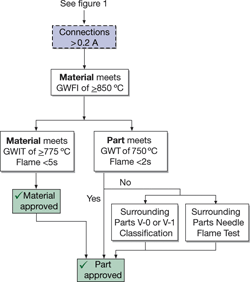
* The GWFI, using a glow wire, establishes the materials’ self-extinguishment/after-flame behaviour in the event of an open fire. This test corresponds to the after-flame test according to UL 94. During the GWFI test (see Figure 3) the material, while allowed to ignite at 850°C, must self-extinguish within less than 30 seconds after the removal of the glow wire. The materials are tested in the form of plates of varying thickness according to IEC 60695-2-12. The material tested must meet this requirement otherwise no approval is possible.
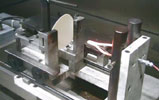
* The GWIT establishes the materials’ ignition behaviour, also using a glow wire. Experience has shown that unattended appliances in particular tend to self-ignite when components fail, causing fires in the process. The intention behind this stricter regulation is to better protect end users against such fires. During the GWIT test, the material may not ignite at 775°C, and the flame must self-extinguish within five seconds. No flaming drip is permitted. Provided that the material tested meets this requirement, components are granted approval without further testing.
* As an alternative to the GWIT, components may also undergo the glow wire temperature test (GWT) because, in essence, their goals are identical. During this test, the finished component may not ignite at 750°C, or the flame must self-extinguish within two seconds. No flaming drip is permitted. This test is performed on finished components according to IEC 60695-2-11. Provided that the materials tested meet this requirement, components are granted approval. Should the flame burn longer than two seconds, approval may still be granted, provided that the surrounding components meet at least the Class V-1 or V-0 requirements as specified in IEC 60695-11-10 or UL 94, or that they pass the needle flame test.
The different goals of UL and IEC
Historically speaking, UL (Underwriter Laboratories) started out as a building insurance company which defined standards governing electrical installations in buildings and appliances in the US in order to prevent fires. That is why it is always the main goal of an UL standard to reduce the risk of an open fire. The UL 94 test measures vertical flame propagation and a material’s dripping behaviour.
Following a conditioning procedure, the specimen is exposed to a flame at 950°C for 10 seconds according to the test setup (Figure 4), whereupon the time required for the flame to self-extinguish is measured. Following a second pass through the same procedure, the ignition of the underlying cotton is also measured. Depending on the after-flame duration, the materials are grouped into flammability classes V-0, V-1 and V-2. The results of these materials tests can be found in UL’s Yellow Card.
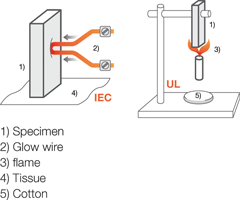
IEC, on the other hand, concentrates mainly on the protection of persons against injury as a result of contact with live parts; it has thus managed to dramatically lower the number of accidents, if not fires. This is due to the fact that there are many cases where appliances self-ignite.
Therefore, and for the protection of end users, the requirements have been tightened for insulating materials used in unattended appliances according to IEC 60335-1. In contrast to UL 94, the test is performed using a glow wire (Figure 4) which establishes the material’s self-extinguishing/after-flame behaviour (GWFI) as well as ignition and dripping on tissue paper (GWIT/GWT).
What does this mean for component manufacturers?
Manufacturers are now challenged to test the compliance with these new requirements of the components in their product range in use in the household appliance industry. If the plastic material used does not meet the standard, alternatives must be sought. Many plastics suppliers have expanded their portfolio of flame-retardant plastics and can now provide the market with the appropriate solutions.
Manufacturers now have to choose between changing over completely or offering additional options. Which path they will take depends on the technical properties on one hand and on the additional cost associated with the new flame-retardant plastics on the other.
Schurter supplies a range of fuse holders, fuse blocks and appliance couplers meeting these stringent requirements. A detailed declaration of approval is included in the VDE certificate of the relevant product.
| Tel: | +27 11 786 0553 |
| Email: | [email protected] |
| www: | www.retron.co.za |
| Articles: | More information and articles about Retron |

© Technews Publishing (Pty) Ltd | All Rights Reserved